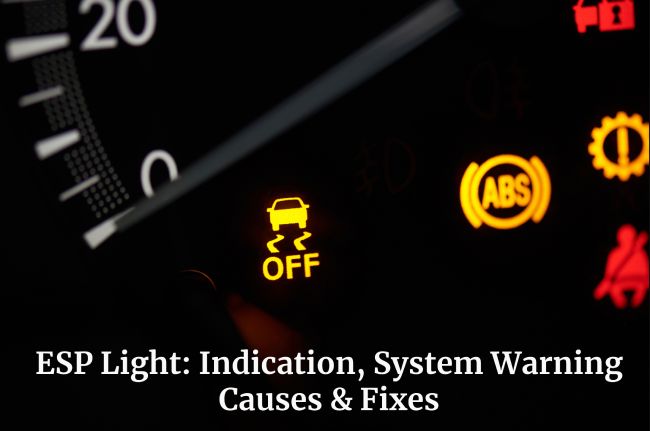Modern cars often feature Electronic Stability Control (ESP). This has been widely credited with the reduction of many accidents on the road.
What should you do if the ESP light on your car illuminates? Read on to discover the meaning, function, and potential causes. Plus, we’ll tell you what steps to take if your vehicle has this issue.
Table of Contents
What Does the ESP Light Indicate?
The ESP Light indicates a problem with your electronic stability program system or that you are driving on slippery surfaces. When these lights illuminate on your dashboard, they indicate that something is wrong.
If the light in your room stays on continuously without flashing on and off, there may be an issue with your Electronic Stability Program.
How Does the ESP System Operate?
The ESP does not work in isolation. It works together with traction control and anti-lock brakes (ABS). Modern cars feature an onboard computer that monitors most of the car’s functions.
When one wheel slips, ESP will engage and control all remaining wheels by cutting power and applying brakes to restore your car’s stability.
When steering dangerously, ESP (Electronic Stability Program) can alert the car’s engine to reduce power output. This helps when revving on slippery ground with no traction on wheels; power will be reduced and you’ll have increased grip.

6 Causes of an ESP Warning Light
The most common reason the ESP light illuminates is due to a malfunctioning ABS sensor or ABS ring. It could also be due to issues with your throttle body, brake pedal switch or steering sensor. If it blinks while driving on slippery surfaces then everything appears to be functioning normally.
It can be challenging to pinpoint the ESP, combined with ABS, that is causing your problem right away.
To determine the cause of an ESP light, it’s always wise to run a diagnostic scan with your laptop computer.
Here is a more in-depth list of the most frequent causes of an ESP light.
1. Faulty ABS Speed Sensor
Wheel sensors transmit speed data about each wheel to the ABS control unit, which then analyzes this data and implements necessary solutions when one or more wheels slip.
If an ABS sensor malfunctions, it could mistakenly believe one wheel is slipping when none are, leading to the illumination of a warning light.
2. Faulty ABS rings
The ABS sensor measures wheel speed based off of the ABS rings, and when these break, it causes the sensor to read an incorrect speed reading.
Failure of Anti-lock Braking System
Another common issue with ABS rings pertains to their durability – when they break, you won’t know that your car’s ABS system was ever malfunctioning in the first place!
3. Faulty Throttle Body
The throttle body is responsible for controlling power output to your car’s electronic stability program (ESP) when it slips. If there’s anything wrong with it, the ESP light will illuminate.
4. Faulty Brake Pedal Switch
The Electronic Stability Program (ESP) system must know when you press the brake pedal. For this function to function optimally, a brake pedal switch must be installed on your pedal.
If the switch is malfunctioning and sending out incorrect data, it could cause the ESP light to illuminate.
5. Defective Steering Angle Sensor
The ESP system relies on steering angle to determine what to do in a slipping situation. If your sensor is becoming worse or isn’t programmed correctly, you may see the ESP light illuminated.
6. ABS Wiring Issues
Your car’s ABS control unit sends wirings from the ABS unit to each wheel sensor at each axle. As these wires move around due to suspension movement, they may become worse as your vehicle ages.
To determine this, measure the ABS sensors from a connector plug at the control unit. To do this, consult a repair manual for the correct pinout.
What should you do if the ESP light comes on?
If your ESP light illuminates, you must check the trouble codes with an OBD2 scanner to identify what is causing it to illuminate. Simply speculating and replacing parts without verifying their validity could prove costly in terms of time and money spent.
To check trouble codes, you have two options: take them to a workshop or use an OBD2 scanner at home for quick results.
FAQs
Is It Safe to Drive with the ESP Light On?
If you are not used to driving without the ESP, then it may not be safe to continue driving with its light on. The ESP system works to maintain traction on slippery surfaces and it’s essential that it works correctly; if the light is on, that indicates an issue with the system and its disablement will result.
Is ESP the same as traction control?
No, the ESP system is distinct from traction control. Traction control helps keep you upright when cornering, while ESP prevents your wheels from spinning on slippery surfaces.
What happens if you drive with the ESP off?
Driving without ESP (External Braking System) will cause your tires to spin freely on slippery surfaces, making it difficult to control your car and may lead to an accident. Therefore, keeping ESP on while driving is highly recommended in order to help protect you and others from accidents.
How can I reset my ESP warning light?
Resetting an ESP warning light requires using an OBD2 scanner, though clearing fault code memory won’t solve the problem permanently. To truly eliminate the light, you need to address what caused it in the first place.
Conclusion
An ESP light indicates a problem with your car’s electronic stability program (ESP) that needs fixing. It may also flash if you are driving on slippery surfaces. The ESP system works in concert with traction control, ABS and engine control systems to maintain vehicle stability.
When you spot an ESP light on your dashboard, the first step to take is to read any trouble codes from ABS, traction control and engine control systems. For this, you’ll need an OBD2 scanner compatible with your vehicle for this task.
If you notice this light coming on and feel uncertain, it’s essential to have your vehicle evaluated by a certified mechanic immediately. While the issue may be minor, such as dirty sensors, it could also indicate more significant issues.
